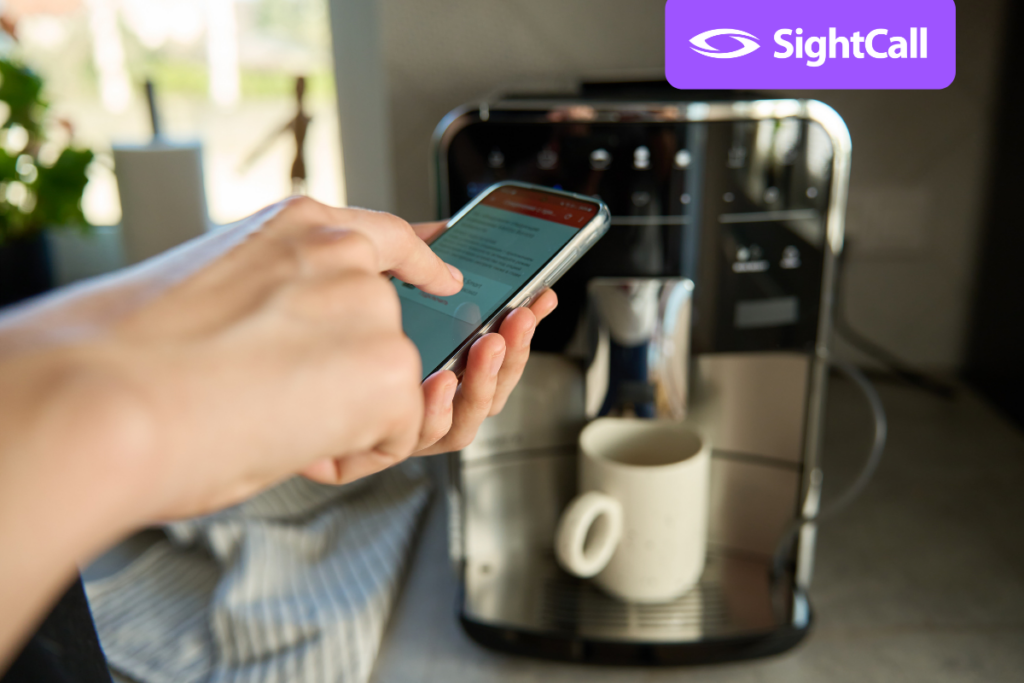In today’s fast-paced landscape, every second counts, and for the customer, a speedy solution is paramount.
When they reach out to your call center, they’re seeking fast, comprehensive, and seamless support. Yet, the current paradigm, which relies heavily on text and voice communication, sometimes falls short.
Misunderstandings can creep in, hindering the efficiency and effectiveness of your agents, and potentially impacting first contact resolution rates.
But imagine a transformation solution: what if your agents could see the customer’s issue, eliminating the guesswork and ambiguity?
This isn’t futuristic fantasy—it’s the next frontier of customer support.
Envision an environment where customers can visually show, in real-time, the challenges they’re grappling with, bypassing the often cumbersome task of verbal description. Cutting-edge technologies are now making it possible to integrate visual assistance, propelling call centers to levels of service excellence previously unattainable.
This is not just an innovation, it’s a game-changer.
Let’s dive deeper into how visual assistance is revolutionizing the world of customer support.
Introducing… Visual Assistance

The use of live video, images, and augmented reality (AR), and AI-powered insights defines visual assistance.
While at first glance, visual assistance may mirror familiar platforms like FaceTime or Zoom, its depth lies in advanced Visual Assistance Platforms (VAPs). These platforms bridge customer service agents and customers, enabling the exchange of real-time visual information, powered by AI-driven insights for seamless communication.
Recent statistics have shown an upward trend in the efficacy of visual assistance. For instance, in 2021, 44% of consumers rated video as being “highly effective” at achieving overall satisfaction. And between 2017 and 2021, use of video in customer service interactions increased by 17%.
VAPs are an innovative solution that many contact centers are adopting to enhance first contact resolution (FCR) and improve overall customer satisfaction. Visual assistance tools make it easier and faster for agents to diagnose and solve problems, help empower customers to solve problems on their own, and break down language barriers that can hinder customer service resolutions.
With tools like live video chat, geolocation, optical character recognition (OCR), augmented-reality (AR), generative AI, and more, VAPs give contact centers the power to design and deploy more intuitive (and more remarkable) customer journeys.
Learn more about the technology behind VAPs.
Diagnose and Solve Problems with Greater Accuracy and Speed
While text-based and verbal communication continue to be crucial in customer service interactions, they often can leave room for misunderstanding, as customers may struggle to accurately describe complex technical issues or product malfunctions.
Visual assistance eliminates this barrier by enabling customers to show agents exactly what they see through live video. This allows agents to clearly see and understand the customer’s issue, allowing them to diagnose and resolve the customer’s problem quickly and accurately.
For instance, imagine a situation where your customer service agent is assisting a customer who is trying to set up or troubleshoot one of your products. Without visual assistance, the customer must take time to verbally describe their situation as accurately as possible, and the agent must then process this information then attempt to blindly guide the customer through a solution.
But with visual assistance, the customer can simply use their smartphone camera to show the product to your agent in real time, along with any connections, error messages, serial numbers, LED lights, or other important information that your agent needs to know. With a clear view of the situation, the agent can then guide the customer step-by-step using annotations or AR overlays, leading to a faster and more successful resolution.
See how SightCall is helping Sciex, the leader in mass spectrometry.
“This is more than just having a video call with a customer. The functionality is absolutely transformational for our business. We can annotate, share documents and diagrams, and steer customers to the actions we want them to take.”
– Senior Service Manager, Sciex
Help Customers Help Themselves

Visual assistance doesn’t just improve the quality and speed of agent-customer interactions. It can also empower customers to solve problems on their own.
Customers can use their smartphones to access AR-guided tutorials and visual troubleshooting resources, using generative AI to create efficient, accurate, and enhanced problem-solving steps for them to follow. Having the option of real-time guidance for simple issues reduces the need for customers to call contact agents for problems that can be self-resolved.
Break Down Language Barriers
When dealing with global customers, contact centers may encounter situations where an agent and a customer cannot communicate effectively due to a language barrier between them.
Visual assistance transcends language barriers by taking advantage of visual cues and demonstrations. An agent can guide a customer through a solution using visual aids, regardless of either’s spoken language or language proficiency.
Not only can using visual assistance tools (in conjunction with other technologies such as real-time speech-to-text translation) improve your customers’ experience where language barriers need to be overcome, but it can also widen your company’s reach to a more diverse customer base.
Take a closer look at SightCall’s Live Translation feature.
Maintain the Human Touch in a Digital Era
With more technology being incorporated into contact center operations, you may be concerned that these solutions will result in service interactions that are less human. But be assured that visual assistance doesn’t replace the human touch. Rather, it augments it.
Visual assistance simply equips your contact centers with powerful tools to provide more effective assistance, while still allowing your customers to build and appreciate personal relationships with your agents.
Visual Assistance and the Future of Exceptional Service
Incorporating visual assistance into contact center operations can revolutionize the way customer issues are addressed. Using real-time visual communication, your contact centers can improve FCR rates, reduce call durations, and enhance overall customer satisfaction.
Embracing innovations like visual assistance, especially those powered by AI, is the road forward for centers striving to excel in our digital age.




